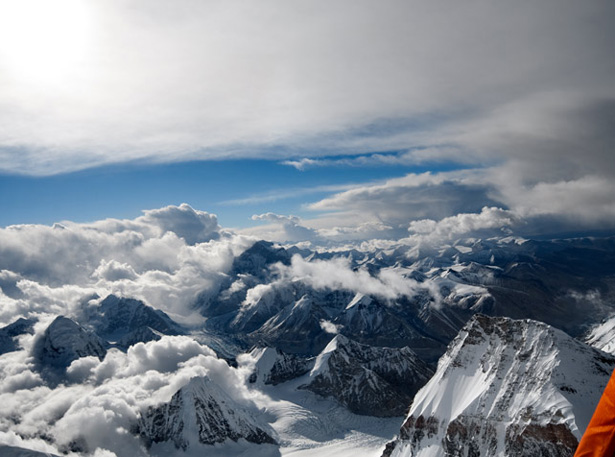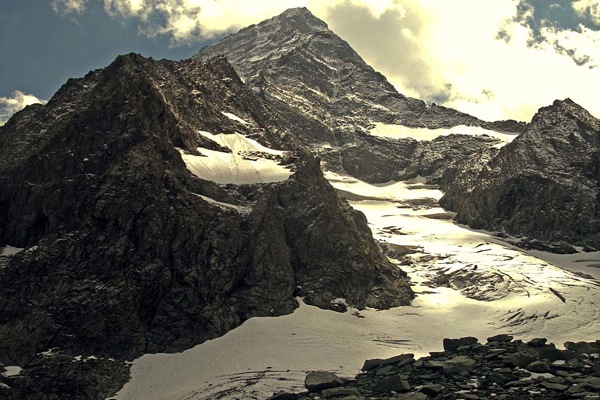
This story is part of a special series that explores the global water crisis. For more clean water news, photos, and information, visit National Geographic's Freshwater website.
The Kolahoi glacier in the western Himalaya is known as Gwash Brani—"goddess of light"—to the millions of people in India and Pakistan who depend on its yearly run-off for survival.
"Kolahoi is our everything," said Ashraf Mohammed Ganai, 24, a lean Kashmiri man who makes his living guiding scientific expeditions to Kolahoi. "Without her, we are lost."
Because of climate change, these glaciers, and the people who rely on them, may now need some divine intervention.
Surrounded by the snow-capped peaks of the world's tallest mountain range, the Kashmir region, disputed over by India and Pakistan, is home to thousands of glaciers. Until recently scientists had claimed they would be gone in just a few decades, mostly based on data from the United Nation's (UN) 2007 Intergovernmental Panel on Climate Change report.
However, in 2009 scientists discovered major flaws with this prediction. A report published in November 2009 claimed the glaciers in the Himalayas are not receding and some have even expanded.
Despite the errors, it's clear that at least some glaciers, including Kolahoi, are still retreating. The latest data from the New Delhi-based Energy and Resources Institute (TERI) shows that in the past four decades, Kolahoi has lost between 15 to 18 percent of its total volume. The research also shows that the glacier is retreating by almost ten feet (three meters) a year.
Climate Change Leader
Locals such as Ganai say they do not need scientists to tell them that the glacier is shrinking.
"My father tells me the tip of the glacier used to be there," said Ganai, pointing to a dried-up river bed visible several kilometers down the mountain. "Now the glacier ends up here."
He lives in a small village called Aru, the last town on the path to Kolahoi, and he spent his youth listening to gunfire crackle through these mountains. For nearly two decades India and Pakistan have waged a bloody dispute over who should lay claim to the Kashmir region, laying down arms in 2002. Prior to 2002, scientists were forced to gather glacial data solely by satellite imaging.
But as relative peace returns to the region, scientists have returned. Last year, TERI established the first program to measure Kashmir's glaciers, selecting Kolahoi, in the Liddar Valley (see map), as a focus area. Ganai was hired by TERI to help with the expeditions to Kolahoi, making him the first in his village to study climate change.
It's 6 a.m. on day two of an expedition led by Ganai, which includes two glaciologist, three journalists, and 24 mountain guides and pony wallahs—men who hire out their ponies to haul supplies.
"Today we are going to dig snow pits on the accumulation zone, at the top of the glacier," explained TERI glaciologist Shresth Tayal as he strapped ice clips to his boots.
As he walked, Tayal's assistant, Nathaniel Dkhar, suggested thinking of Kolahoi "as a huge bucket with a hole in the bottom."
"If you have more water going out than you have coming in, you have a negative mass balance, and the glacier is shrinking," Dkhar said. "That's exactly what's happening to Kolahoi and thousands of other glaciers across the Himalaya."
Himalayan Glacier Research Has Global Impact
Though Ganai does not have enough scientific experience to trek to the accumulation zone, he and six other members of the team play a vital role collecting data on the lower portions of the glacier know as the ablation zone, or the area where the ice melts.
Ganai and colleagues first drill a series of holes into the ice of the ablation zone and then take pre-measured sticks (literally bamboo poles) and place them in the holes. After each melting season, the team will measure the length of the pole exposed, take notes, and repeat the procedure. This tells them how much the volume of the glacier has changed between melting seasons.
The process may sound elementary, but it's extremely tedious and labor-intensive. Much of the cutting and drilling takes place at heights of 13,000 feet (3,962 meters) on icy crevasses, where a mishap could mean severe injury or even death. While taking measurements on the accumulation zone on this expedition, Tayal slipped through a crevasse and fractured his tailbone.
Despite the risk, Tayal believes the research done on Kolahoi will have a global impact.
"We do not have much reliable data on western Himalayan glaciers," he said.
"If you want to know what the global impact of climate change is going to be and make accurate projections, you can not exclude the Himalaya from the Rockies and the Alps."
"No Good Anymore"
To measure the flow of meltwater through the Liddar Valley, TERI established a monitoring station. Genai helped build the structure in the West Liddar River, the main tributary of the Jhelum River, which is one of the largest rivers in Kashmir.
Each day the station is collecting data on a looming disaster, Tayal said.
As the glaciers in the western Himalaya disappear, seasonal run off coming into Pakistan from Kashmir could drop by 40 percent, according to the Washington, D.C.-based research institute the Woodrow Wilson Center.
This will no doubt have a devastating effect on the millions who depend on the run off, experts say.
And some people downstream from Kolahoi are already suffering. The bakarwals, or nomadic herders, who bring hundreds of thousands of sheep to graze in the Liddar Valley have dealt with unpredictable water fluxes in recent years.
"We used to know when the waters would be in the river," said a middle-aged bakarwal woman, as she smacked a few of her sheep that had scattered from the herd.
"But now the waters are too high or too low. I want my children to get an education," the mother of three said. "This way of life is no good anymore."
Ganai is also worried. "We are dependent on the beauty of Kashmir," he said, looking at the mountain skyline.
"If Kolahoi goes, I don't know what we will do."




